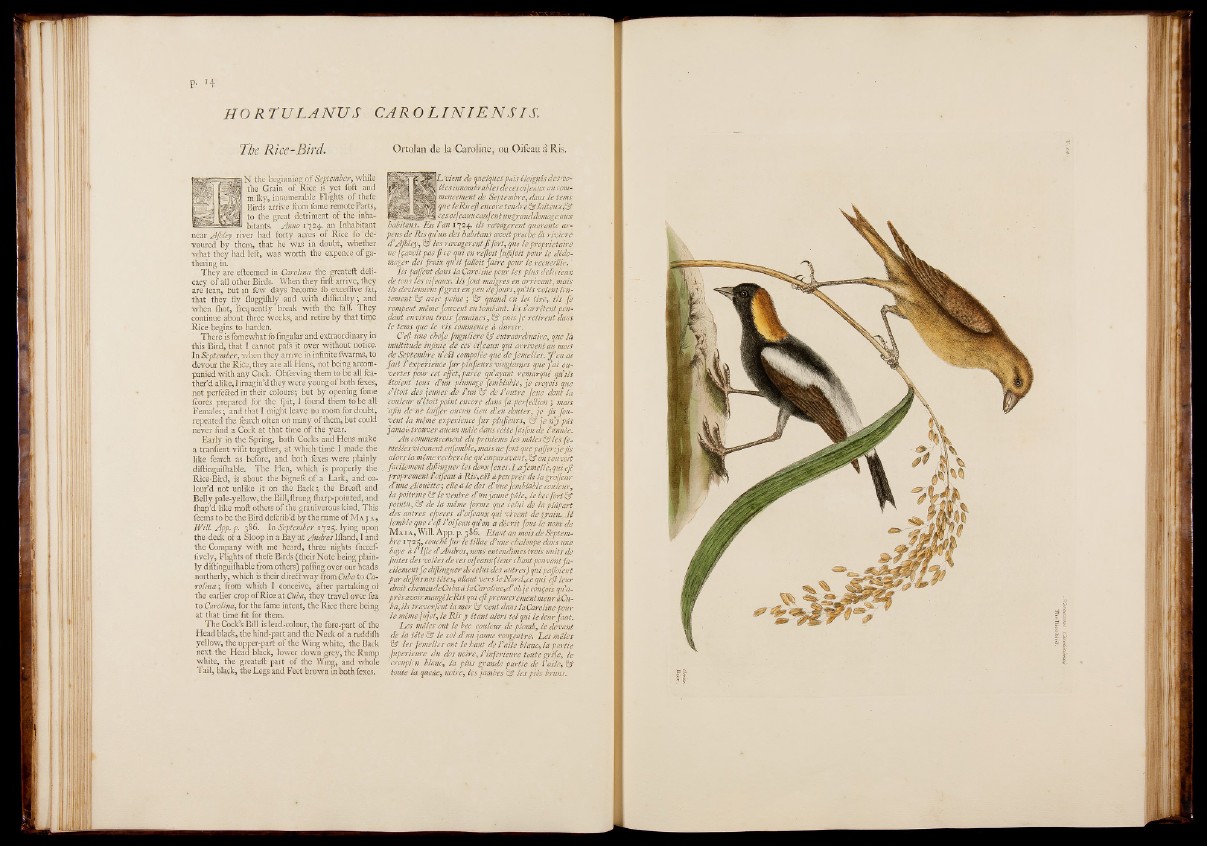
He Rice-Bird. Ortolan de la Caroline, ou Oifeau à Ris.
N the beginning of September, while
the Grain of Rice is yet foft and
milky, innumerable Flights of thefe
Birds arrive from fome remote Parts,
to the great detriment of the inhabitants.
Anno 1724. an Inhabitant
near AJhley river had forty acres of Ricè fo devoured
by them, that he was in doubt, whether
what they had left, was worth the expence of gathering
in.
They are efteemed in Carolina the greateft delicacy
of all other Birds. When they firft arrive, they,
are lean, but in few days become fo exceffive fat,
that they fly fluggifhly and with difficulty; and
when ihot, frequently break with the fall. They
continue about three weeks, and retire by that time
Rice begins to harden.
There is fòméwhat fo Angular and extraordinary in
this Bird, that I cannot pafs it over without notice.
In September, when they arrive in infinite fwarms, to
devour the Ric'e, they are all Hens, not being accompanied
with any Cock. Obferving them to be all feather’d
alike, I imagin’d they were young of both fexes,
not perfeóted in their colours; but by opening fome
icorès prepared for the (pit, I found them to be all
Females;’ and that I might leave no room for doubt,
repeated the fèarch often on many of themj but could
never find a Cock at that time of the year.
Early in the Spring, both Cocks and Hens make
a tranfient vifit together, at which‘time I made thè
like fearch as before, and both (exes were plainly
diftinguifhable. The Hen,-which is properly the
Rice-Bird, is about the bignefs of a Lark, and colour’d
not unlike it on the Back; the Breaftand
Belly pale-yellow, the Bill,ftrong fharp-pointed, and
ihap’d like moft others o f the graniverous kind. This
ièems to be the Bird defcrib’d by the name of M a j a ,
Will. App. p. 386. In September 172 5. lying upon
the deck of a Sloop in a Bay 'at Andros Ifland, I and
the Company with me heard; three nights fuccef-
fively, Flights of thefe Birds (their Note being plainly
diftinguifhable from others) paifing over our heads
northerly, which is their direft way from Cuba to Carolina
; from which I conceive, after partaking of
the earlier crop of Rice at Cuba, they travel over fea
to Carolina, for the fame intent, the Rice there being
at that time fit for them.
The Cock’s Bill is lead-colour, the fore-part of the
Head black, the hind-part an.d the Neck of a reddifh
yellow, the upper-part of the Wing white, the Back
next the Head black, lower down grey, the Rump
white, the greateft part of the Wing, and whole
Tail, black, the Legs and Feet brown in both fexes.
L vient de quelques pais éloignés des vo-
lé es innombrables de cesoijeaitx au commencement
de Septembre, dans le tems
que leRis eft encore tendre lait eux fA
ces oijeaux caujent itngranddomagc aux
habitans. En fan 1724. ils ravagèrent quarante ar-
pens de Ris qu'un des habitans avoit proche la riviere
d'Afhley, & les ravagèrent f i fort, que le propriétaire
ne Jçavoit pas fi ce qui en reftoit fujfifoit pour le dédo-
viager des fraix qu'il falloit faire pour le.recueillir. '
Ils paffént dans la Caroline pour les plus délicieux
de tous les'ciseaux, d is font maigres en arrivant, mais
ils deviennent f i gras enpèu de fours, quils Volentlentement^
avec peine ; 0* qijand àn les t ir e I ls Je
rompent même joûveni en tombant. Ils s'arrêtent pendant
environ trois fem aines,& puis jeretirent dans
le tems que le ris commence a durcir.
C'eft une chofejfngulieré & extraordinaire, que là
multitude infinie dè ces ézf eaux qui arrivent au mois
de Septembre n'eîl compofée que de femelles. J'e n ai
fait l'eripefiéhce fu r plufleurl vingtaines que j'a i ouvertes
pour cet effet, parfe qu'ayant remarqué qu'ils
êtoient tous d'un ' plumage femblable, je croyois que
c'étoit des jeûnes de VunfiA de l'autre [exe dont la
couleur riétoit point. encore dans fa perfeélion ; mais
'afin de'nè làïfjèr aucun lieu d'.en douter, je fis fou-
vent la même erper.ience fu r plufieurs, je n'y pus
jamais trouver aucun maie dans cette faifon de l'année.
'Au commencement du printèms les m â le sle s, femelles
viennent enfemble, mais ne font que pàffer:je fis
alors la même recherche qriauparavant, w on pouvoit
facilement diflinguer les deux fexes. L a femelle, qui eft
proprementl?oifeau à R is, eM à peu près de lagroffeur
dune Alouette ; elle a le dos d'une femblable couleur,
la poitrine & le ventre d'un jaune pâle, le bec fort
pointu, 0* de la même forme que celui de la plupart
des autres efpeces d'oifeaux qui vivent de grain. I l
femble que c'efl l'oifeau qu'on a décrit fous le nom-de
M a 1 a , Will. App. p. 3 86. Etant au mois de Septembre
17255 couché fur letiUac d'une chaloupe dans une.
baye à l'Ifle dAndros, nous entendîmes trois nuits de
fuites des volées de ces oifeaux(leur chant pouvant fa cilement
fe diflinguer de celui des autres) qui paffoient
par deffus nos têtes, allant vers le Nord, ce qu j efi leur
droit chemindeCubaàlaCaroline,d'oîijeconçois qu'a-
près avoir mangé leRis qui eft premièrement meur à Cuba,
ils traverfent la mer 0 * vont dans la Caroline pour
le même fujet, le R is y étant alors tel qui le leur faut.
L e s mâles ont lé bec couleur de plomb, le devant
de la tête 0 * le col d'un jaune rougeâtre. Les mâles
& les femelles ont le haut de l'a ile blanc, la partie
fuperieure du dos noire, l'inférieure toute griffe, le
*croupicn blanc, la plus grande partie de Paile, 0?
toute la, qiueiié% noire, les jambes 0 1 les piês bruns.